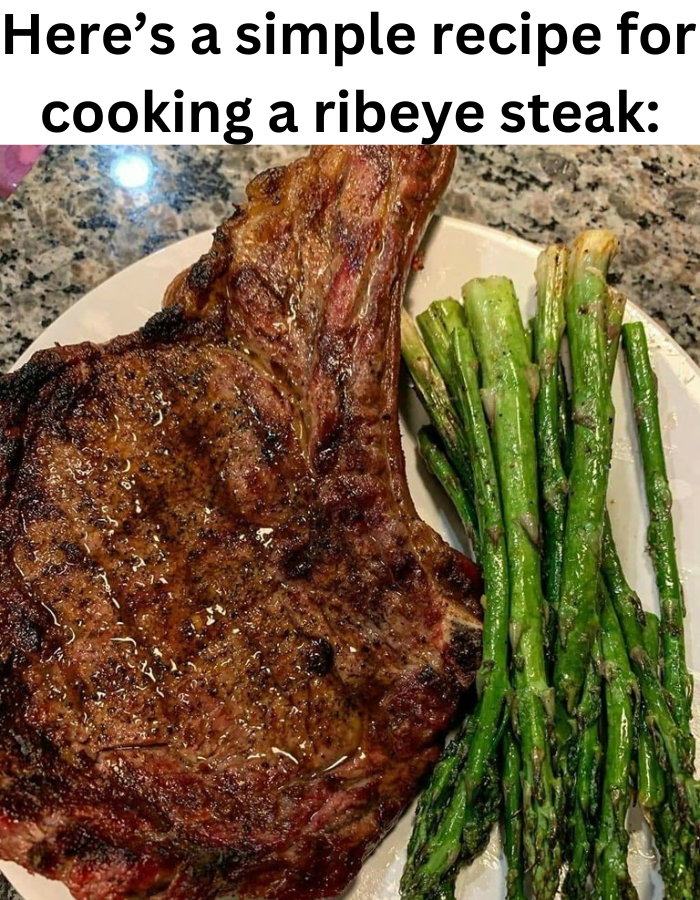A ribeye steak is a carnivore’s delight, celebrated for its exceptional tenderness, rich marbling, and exquisite flavor profile. This delectable cut is sourced from the rib section of the bovine, precisely from the rib primal, nestled temptingly between the robust chuck and the refined loin.

When it comes to savoring the epitome of beefy perfection, the ribeye steak reigns supreme, offering a culinary experience that is nothing short of sublime.
Certainly, here’s a different text about ribeye steak characteristics, followed by a simple recipe:
Ribeye steaks boast a set of distinctive characteristics that make them a favorite among meat enthusiasts:
- Marbling: Ribeye steaks showcase a generous marbling of fat throughout the meat, rendering them tender, succulent, and deeply flavorful. This intramuscular fat melts during cooking, saturating the steak with moisture and taste.
- Bone-in or Boneless: Ribeye aficionados have a choice between bone-in and boneless cuts. The bone-in option not only adds a touch of flavor but also presents a dramatic, eye-catching appearance. On the other hand, boneless ribeyes offer ease of consumption.
- Size and Thickness: Ribeye steaks vary in size and thickness to suit individual preferences, ranging from modest 8-ounce (225 grams) portions to substantial 16-ounce (450 grams) cuts or even larger, ensuring there’s a perfect ribeye for everyone.
- Cooking Techniques: The versatility of ribeye steaks allows for a range of cooking methods, including grilling, pan-searing, broiling, or the precise control of sous-vide cooking. The ultimate goal is to achieve a juicy, tender interior with a beautifully seared crust.
- Seasoning and Flavors: While ribeye steaks possess a robust, beefy flavor on their own, seasoning choices are virtually limitless. They can be elevated with a minimalist blend of salt, pepper, and herbs or infused with flavors through marinades or rubs, catering to individual palates.
- Preferred Doneness: Ribeye steaks are amenable to various levels of doneness, from a lusciously rare interior to a well-done finish. However, many connoisseurs prefer medium-rare or medium, as it maintains the steak’s inherent tenderness and amplifies its natural taste.
Ribeye steaks, with their tantalizing attributes, are a go-to choice for steak lovers. Whether served as a stand-alone star of the meal or paired with complementary sides like roasted vegetables, creamy mashed potatoes, or a fresh, crisp salad, they never fail to deliver a memorable dining experience.
Here’s a simple recipe for cooking a mouthwatering ribeye steak:
Ingredients:
- 1 ribeye steak (bone-in or boneless, based on preference)
- Salt and freshly ground black pepper
- Olive oil
- Optional: Garlic cloves and fresh herbs (rosemary or thyme)
Instructions:
- Preparation: Take the ribeye steak out of the refrigerator and allow it to come to room temperature for about 30 minutes before cooking. This ensures even cooking.
- Season: Season both sides of the steak generously with salt and freshly ground black pepper. For extra flavor, you can add minced garlic and fresh herbs at this stage.
- Heat the Grill or Pan: Preheat your grill or a heavy skillet (preferably cast iron) over high heat. Add a drizzle of olive oil to prevent sticking.
- Sear: Place the ribeye steak onto the hot grill or skillet. For a medium-rare steak, cook for about 3-4 minutes on each side, turning only once. Adjust the time based on your preferred level of doneness.
- Rest: After cooking, remove the steak from the heat and let it rest for 5-10 minutes on a cutting board. This allows the juices to redistribute and keeps the steak juicy.
- Slice and Serve: Slice the ribeye against the grain into thin strips. Serve immediately with your favorite sides.
